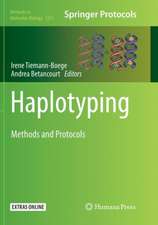Epitranscriptomics: Methods and Protocols: Methods in Molecular Biology, cartea 1870
Editat de Narendra Wajapeyee, Romi Guptaen Limba Engleză Hardback – 12 dec 2018
Authoritative and comprehensive, Epitranscriptomics: Methods and Protocols is an important resource for both expert and novice scientists who are interested in learning more aboutthis field.
Din seria Methods in Molecular Biology
- 9%
 Preț: 791.63 lei
Preț: 791.63 lei - 23%
 Preț: 598.58 lei
Preț: 598.58 lei - 20%
 Preț: 882.98 lei
Preț: 882.98 lei -
 Preț: 252.05 lei
Preț: 252.05 lei - 5%
 Preț: 802.70 lei
Preț: 802.70 lei - 5%
 Preț: 729.61 lei
Preț: 729.61 lei - 5%
 Preț: 731.43 lei
Preț: 731.43 lei - 5%
 Preț: 741.30 lei
Preț: 741.30 lei - 5%
 Preț: 747.16 lei
Preț: 747.16 lei - 15%
 Preț: 663.45 lei
Preț: 663.45 lei - 18%
 Preț: 1025.34 lei
Preț: 1025.34 lei - 5%
 Preț: 734.57 lei
Preț: 734.57 lei - 18%
 Preț: 914.20 lei
Preț: 914.20 lei - 15%
 Preț: 664.61 lei
Preț: 664.61 lei - 15%
 Preț: 654.12 lei
Preț: 654.12 lei - 18%
 Preț: 1414.74 lei
Preț: 1414.74 lei - 5%
 Preț: 742.60 lei
Preț: 742.60 lei - 20%
 Preț: 821.65 lei
Preț: 821.65 lei - 18%
 Preț: 972.30 lei
Preț: 972.30 lei - 15%
 Preț: 660.49 lei
Preț: 660.49 lei - 5%
 Preț: 738.41 lei
Preț: 738.41 lei - 18%
 Preț: 984.92 lei
Preț: 984.92 lei - 5%
 Preț: 733.29 lei
Preț: 733.29 lei -
 Preț: 392.60 lei
Preț: 392.60 lei - 5%
 Preț: 746.26 lei
Preț: 746.26 lei - 18%
 Preț: 962.66 lei
Preț: 962.66 lei - 23%
 Preț: 860.22 lei
Preț: 860.22 lei - 15%
 Preț: 652.64 lei
Preț: 652.64 lei - 5%
 Preț: 1055.50 lei
Preț: 1055.50 lei - 23%
 Preț: 883.87 lei
Preț: 883.87 lei - 19%
 Preț: 491.89 lei
Preț: 491.89 lei - 5%
 Preț: 1038.86 lei
Preț: 1038.86 lei - 5%
 Preț: 524.16 lei
Preț: 524.16 lei - 18%
 Preț: 2122.34 lei
Preț: 2122.34 lei - 5%
 Preț: 1299.23 lei
Preț: 1299.23 lei - 5%
 Preț: 1339.12 lei
Preț: 1339.12 lei - 18%
 Preț: 1390.26 lei
Preț: 1390.26 lei - 18%
 Preț: 1395.63 lei
Preț: 1395.63 lei - 18%
 Preț: 1129.65 lei
Preț: 1129.65 lei - 18%
 Preț: 1408.26 lei
Preț: 1408.26 lei - 18%
 Preț: 1124.92 lei
Preț: 1124.92 lei - 18%
 Preț: 966.27 lei
Preț: 966.27 lei - 5%
 Preț: 1299.99 lei
Preț: 1299.99 lei - 5%
 Preț: 983.76 lei
Preț: 983.76 lei - 5%
 Preț: 728.16 lei
Preț: 728.16 lei - 18%
 Preț: 1118.62 lei
Preț: 1118.62 lei - 18%
 Preț: 955.25 lei
Preț: 955.25 lei - 5%
 Preț: 1035.62 lei
Preț: 1035.62 lei - 18%
 Preț: 1400.35 lei
Preț: 1400.35 lei
Preț: 1108.51 lei
Preț vechi: 1166.84 lei
-5% Nou
Puncte Express: 1663
Preț estimativ în valută:
212.12€ • 223.05$ • 175.27£
212.12€ • 223.05$ • 175.27£
Carte disponibilă
Livrare economică 27 martie-10 aprilie
Preluare comenzi: 021 569.72.76
Specificații
ISBN-13: 9781493988075
ISBN-10: 1493988077
Pagini: 300
Ilustrații: XII, 298 p. 57 illus., 41 illus. in color.
Dimensiuni: 178 x 254 mm
Greutate: 0.77 kg
Ediția:1st ed. 2019
Editura: Springer
Colecția Humana
Seria Methods in Molecular Biology
Locul publicării:New York, NY, United States
ISBN-10: 1493988077
Pagini: 300
Ilustrații: XII, 298 p. 57 illus., 41 illus. in color.
Dimensiuni: 178 x 254 mm
Greutate: 0.77 kg
Ediția:1st ed. 2019
Editura: Springer
Colecția Humana
Seria Methods in Molecular Biology
Locul publicării:New York, NY, United States
Cuprins
Bisulfite Sequencing of RNA for Transcriptome-Wide Detection of 5-Methylcytosine.- Single-Molecule Analysis of RNA Dynamics in Living Cells Using Molecular Beacons.- Visualization of Xist Long Non-Coding RNA with Fluorescent CRISPR/CAS9 System.- HAMR: High-Throughput Annotation of Modified Ribonucleotides.- High-Resolution Mapping of N6-Methyladenosine Using m6A Crosslinking Immunoprecipitation Sequencing (m6A-CLIP-seq).- Direct Chemical Biotinylation of RNA 5’-Ends Using a Diazo Reagent.- Identification of Methylated Transcripts Using the TRIBE Approach.- Decoding the Atlas of RNA Modifications from Epitranscriptome Sequencing Data.- Detection of MicroRNA-Mediated Target mRNA Cleavage and 3'-Uridylation in Human Cells by a SLA-RT-PCR Analysis.- Genome-Wide Annotation of circRNAs and Their Alternative Back-Splicing/Splicing with CIRCexplorer Pipeline.- Synthesis and Evaluation of Novel Neamine-Nucleoside Conjugates as Potential Antibiotic Targets for Escherichia coli 16S RibosomalRNA.- Electron Microscope Detection of 5-Methylcytosine on DNA and RNA.- Immuno-Northern Blotting: Detection of Modified RNA Using Gel Separation and Antibodies to Modified Nucleosides.- LncVar:Deciphering Genetic Variations Associated with Long Non-Coding Genes.- Guided Reconstruction of Full-Length Isoforms from Short Reads by CIDANE.- Profiling of N6-Methyladenosine in Zika Virus RNA and Host Cellular mRNA.- Detection and Quantification of Pseudouridine in RNA.- 5-Methylcytosine Analysis by RNA-BisSeq.- RNA Modification Regulatory Genes in DNA Damage.- Dot Blot Analysis for Measuring Global N6-Methyladenosine Modification of RNA.
Textul de pe ultima copertă
This volume provides readers with the latest technologies to study changes in the epitranscriptome. The protocols described in this book explore both targeted and unbiased high-throughput analysis associated with post-transcriptional RNA modification. The chapters in this book also cover specific topics such as transcriptome-wide detection of 5-methylcytosine; HAMR; iRNA-2OM; genome-wide annotation of circRNAs; immune-northern blotting; and detection and quantification of pseudouridine in RNA. Written in the highly successful Methods in Molecular Biology series format, chapters include introductions to their respective topics, lists of the necessary materials and reagents, step-by-step, readily reproducible laboratory protocols, and tips on troubleshooting and avoiding known pitfalls.
Authoritative and comprehensive, Epitranscriptomics: Methods and Protocols is an important resource for both expert and novice scientists who are interested in learning more about this field.
Authoritative and comprehensive, Epitranscriptomics: Methods and Protocols is an important resource for both expert and novice scientists who are interested in learning more about this field.
Caracteristici
Includes cutting-edge methods and protocols Provides step-by-step detail essential for reproducible results Contains key notes and implementation advice from the experts


























